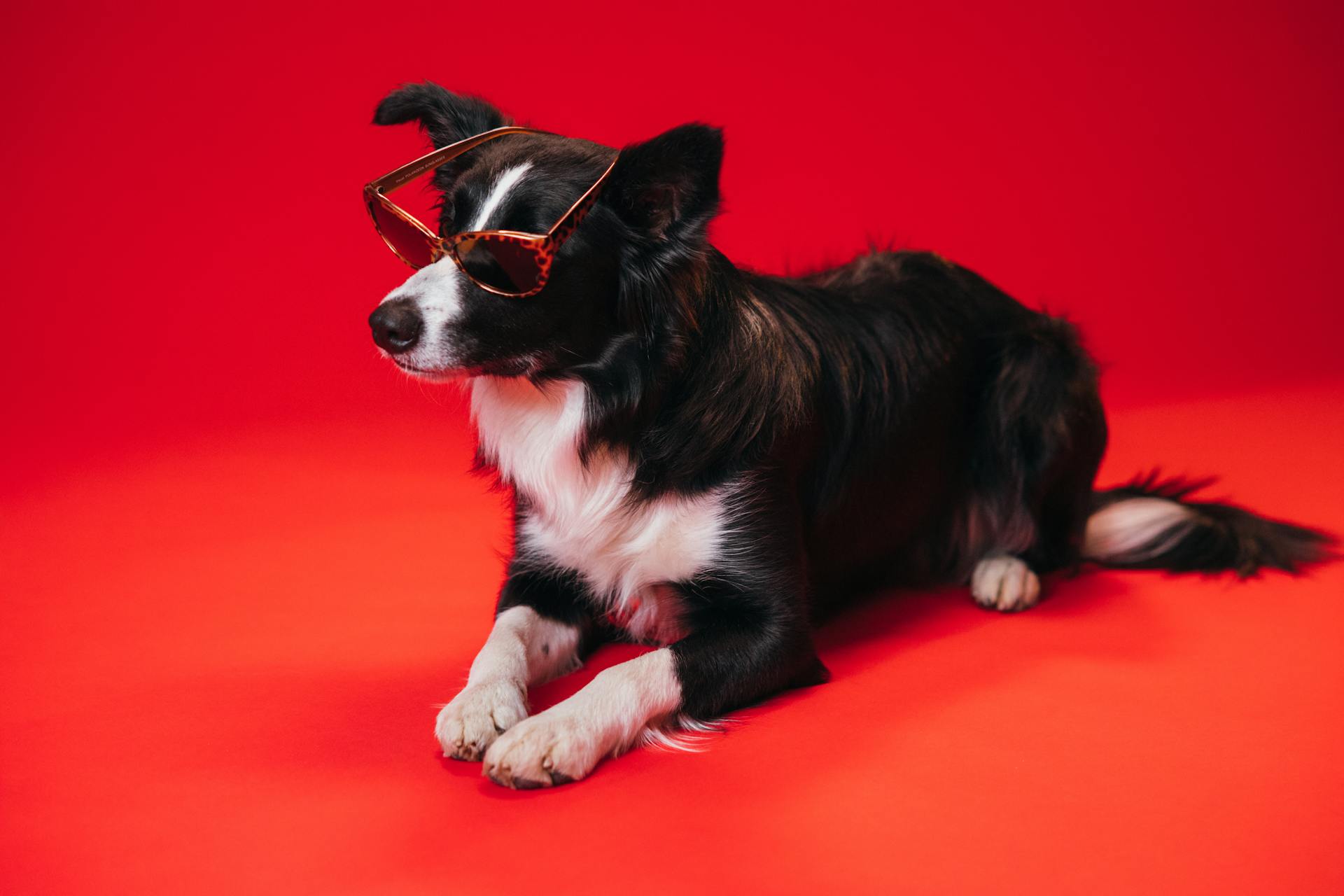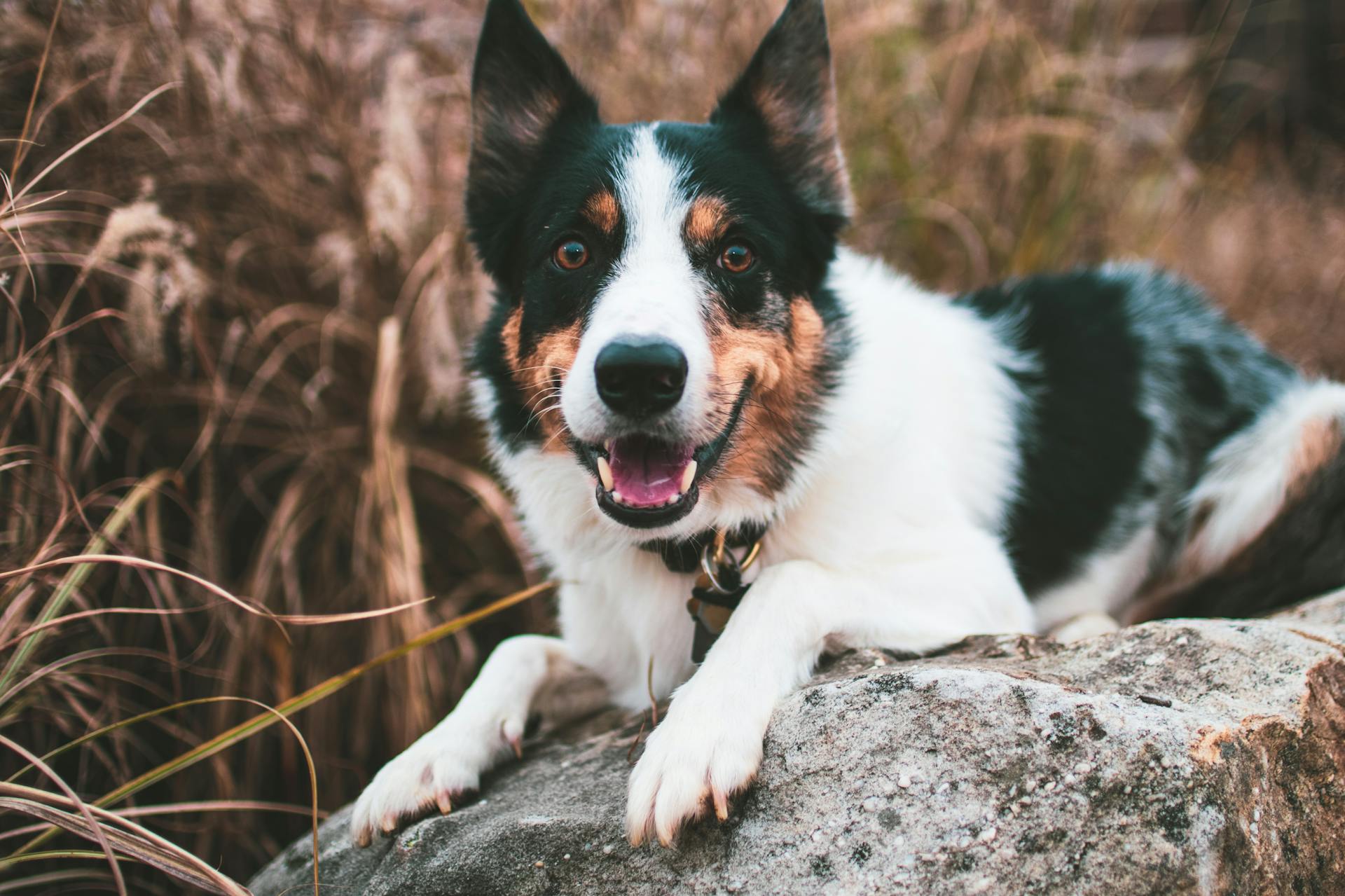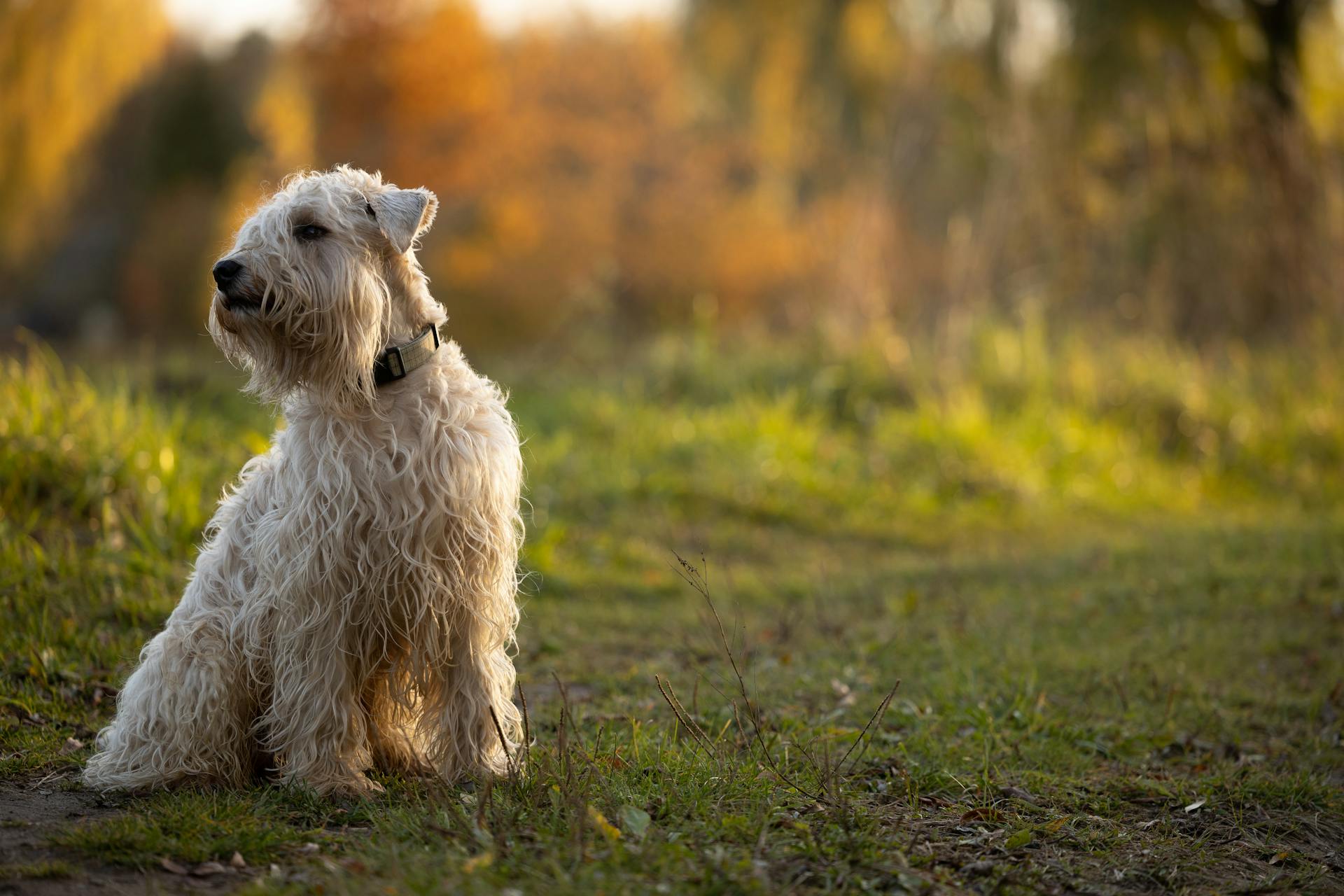
The Border Terrier Scotland breed is a beloved companion known for its friendly and outgoing personality. They have a strong prey drive and were originally bred to hunt small game.
Originating from the Anglo-Scottish border, this breed has a rich history dating back to the 18th century. They were highly valued for their ability to track and flush out foxes and other small game.
Border Terriers are a relatively small breed, typically weighing between 13-16 pounds and standing 10-15 inches tall at the shoulder. Their short, dense coat requires minimal grooming.
Their intelligence and energetic nature make them well-suited for active families or individuals who can provide regular exercise and mental stimulation.
Check this out: Game Bred American Pit Bull Terrier
Vital Stats
If you're considering bringing a Border Terrier into your life, here are some key facts to keep in mind.
Their size is relatively small to medium, making them a great fit for families with smaller living spaces.
Border Terriers have a double coat that requires regular grooming, typically once a week, and some owners choose to hand strip their coat for a more authentic look.
These dogs are active and need at least one hour of exercise per day, which is why they're best suited for families who can commit to regular outdoor activities.
On average, Border Terriers can live for 12 years or more with proper care and attention.
As a member of the Terrier breed group, Border Terriers are known for their intelligent and lively personalities.
Their temperament is often described as smart, loving, and cheeky, making them a great companion for many families.
Temperament & Personality
Border Terriers are known for their plucky independence and self-assurance, making them less prone to separation anxiety than other breeds. However, this can also make them a bit stubborn at times.
They have a high prey drive, which means they'll chase small animals like cats, squirrels, and rabbits if not properly socialized. This is an important consideration for cat owners or those with small pets.
Border Terriers are curious dogs that love to be included in fun activities and can easily be trained with positive reinforcement. They don't do well with harsh discipline, so a firm but fair attitude is a must.
They thrive on having a purpose, which is why they excel in agility training and enjoy having new toys to chew and play with. Border Terriers can make excellent companions for children, but they can be a bit too spunky for small kids.
Some Border Terriers may not get along with other same-sex dogs, so introducing them to other animals requires extra care. They're also prone to being very vocal, with a loud bark that can be heard from a distance.
Here are some key traits to keep in mind when considering a Border Terrier:
- Plucky independence and self-assurance
- High prey drive and tendency to chase small animals
- Curiosity and love of fun activities
- Easy to train with positive reinforcement
- Prone to being vocal and loud
- May not get along with other same-sex dogs
Training & Exercise
Training and exercise are crucial for Border Terriers to stay happy and healthy. They're quick learners, but their independent nature means they need consistent training from a young age.
Their high prey drive can make them stubborn at times, so it's essential to use positive reinforcement training methods. A tasty, low-calorie treat can be a great motivator to keep them on track.
Border Terriers need at least an hour of physical exercise per day, which can be split into a couple of walks with some off-lead time in a secure area. This should be combined with plenty of mental stimulation through games and activities.
Their sensitive nature means they respond best to positive reinforcement, so avoid punishment-based training methods. Early socialisation is also vital to prevent unwanted behaviour such as chasing and aggression.
To keep your Border Terrier engaged, try hiding their meals across the garden for them to hunt out, or play ball games to make recall training fun.
Here's a rough guide to the daily exercise needs of your Border Terrier:
Remember, every dog has its own personality, so it's essential to tailor your training and exercise approach to your Border Terrier's unique needs.
How Much Grooming Does a Dog Need?
Border Terriers require regular grooming to prevent matting and tangling of their coats. This is especially important since their double coat sheds all year round.
You'll need to brush your Border Terrier a couple of times a week, as their short fur still sheds. This will help keep their coat looking its best.
Clipping is generally not recommended, as it can cause the coat to lose its colour and texture. Instead, hand-stripping is a better option, but this is best left to professional groomers.
If your Border Terrier enjoys digging, they may need a wash from time to time. Their coats are also hypoallergenic, making them a good choice for owners with allergies.
Here are some grooming needs to consider:
- Brushing: 2-3 times a week
- Washing: as needed (usually due to digging)
- Professional grooming: recommended for hand-stripping
How Much Food Does a Dog Need?
Feeding your Border Terrier the right amount of food is crucial for their overall health and wellbeing. They have big appetites, so it's essential to monitor their food intake carefully.
Their food needs to have enough energy to fuel their active lives, but without overfeeding. This is especially important as they can be prone to developing diabetes.
A Border Terrier's food needs depend on their age, size, activity levels, fitness, and weight. You can use the information on dog food packets as a guide, but remember to take your dog's individual needs into account.
To determine the right amount of food, you can use the following factors:
- Age
- Size
- Activity levels
- Fitness
- Weight
Your dog's body condition is also helpful for deciding how much food to give your dog. You can find more about body condition scoring from the World Small Animal Veterinary Association (WSAVA). If you're not sure, ask your vet for advice.
Health
As you're considering bringing a Border Terrier into your family, it's essential to be aware of the potential health issues that can affect this breed.
Border Terriers are prone to certain health conditions, including cataracts and retinal dysplasia.
Regular health checks can help identify these issues early on. A Fanconi urine test, blood and urine protein screens, and eye examination are all important tests to have done on your Border Terrier.
Not every Border Terrier will develop these health issues, but it's good to be prepared.
If you're thinking of buying a Border Terrier puppy, it's a good idea to speak to your local vet about potential health issues and how to find a responsible breeder.
All dogs need basic preventative health care, including vaccinations and flea and worming treatments.
Here are some common health problems that can affect Border Terriers:
- Luxating patellas – where the kneecaps slip temporarily out of place
- Skin problems
- Ear problems
- SLEM (Spongiform LeucoEncephaloMyelopathy) or shaking puppy syndrome
- Canine Epileptoid Cramping Syndrome (CECS) – tremors, muscle spasms, seizures, affecting whole or part of body
- Canine Gallbladder Mucocoele – this is where the gall bladder has difficulty emptying and may require surgical removal
To reduce the chances of your puppy being affected by certain conditions, it's recommended to look for a Kennel Club Assured Breeder who meets extra requirements that benefit your puppy's health.
History
The Border Terrier has a rich history that spans centuries. Originally, the breed was referred to as the Coquetdale Terrier or Redesdale Terrier, named after the areas in which it originated.
These early Border Terriers were developed by farmers and shepherds from the border of England and Scotland to help reduce the fox population. Foxes were capable predators that were hunting farm animals.
The breed became known as the Border Terrier in the 1800s due to its association with the Border Hunt in Northumberland. This name change marked a significant shift in the breed's role, as it transitioned from a working farm dog to a hunting companion for the nobility.
Border Terriers are believed to be related to Bedlington Terriers and Dandie Dinmont Terriers, which were also from the same area. This shared ancestry is a testament to the breed's origins in the border region.
In the 19th century, foxhunting became a sport, and the Border Terrier played a key role in the chase. Their legs had to be long enough to keep up with the horses and hounds but short enough to crawl inside the fox's den.
The breed's popularity grew when it was officially recognized by the English Kennel Club as a distinct breed. This recognition paved the way for the Border Terrier to become a registered breed with the American Kennel Club in 1930.
See what others are reading: American Kennel Club Lancashire Heeler
Appearance
The Border Terrier's appearance is quite distinctive. They have an otter-shaped head with a broad skull and a short, dark-colored muzzle.
Their short, coarse hair comes in a variety of colors including red, blue, tan, wheaten, or grizzle and tan. This unique coat is not only stylish but also dirt-resistant thanks to its coarse outer layer.
A Border Terrier's small, keen eyes give them a mischievous expression, which is sure to bring a smile to your face. They also have a short, thick tail that's moderately short at the base.
Standard Colors
The Border Terrier's coat is one of its most distinctive features. They have a double coat that is short and dense, with a soft undercoat and a coarse, dirt-resistant, outer coat.
Their coat comes in a variety of colors, including red, blue, tan, wheaten, and grizzle and tan. The breed standard colors for the Border Terrier include several different options.
Here are the breed standard colors for the Border Terrier:
- Blue & Tan
- Dark Grizzle
- Dark Grizzle & Tan
- Dark Red Grizzle
- Grizzle
- Grizzle & Tan
- Light Grizzle
- Red
- Red Grizzle
- Wheaten
These colors are a result of the breed's unique genetics and are a key part of what makes the Border Terrier so recognizable.
Maintenance
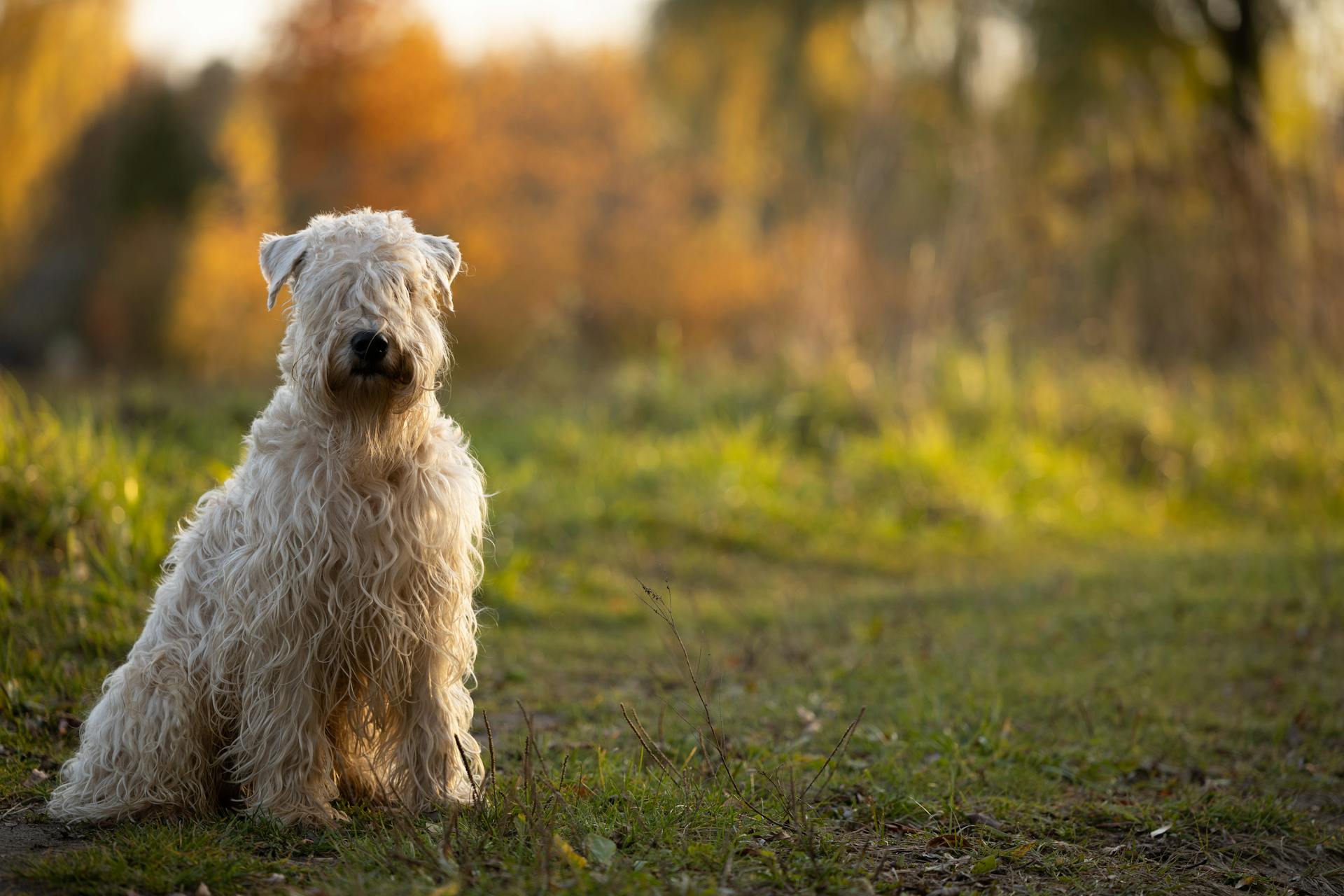
The Border Terrier's appearance is just one aspect of what makes them such wonderful companions. Their coats are relatively low-maintenance, requiring only weekly brushing to keep them looking their best.
Their outer coat needs to be hand-stripped a few times a year to remove dead hair, but this is a simple process that can be done at home.
One of the best things about the Border Terrier's coat is that they shed very little, making them a great choice for people with allergies.
You won't need to bathe your Border Terrier frequently, but when you do, be sure to use a shampoo specifically designed for their coat type.
For exercise, these dogs are high-energy and need daily activity to stay happy and healthy. They can thrive in both apartments and houses, as long as they get the physical and mental stimulation they need.
If you're looking for ways to keep your Border Terrier engaged, consider using fun hide-and-seek toys to prevent boredom.
On a similar theme: When Is It Best to Breed a Dog
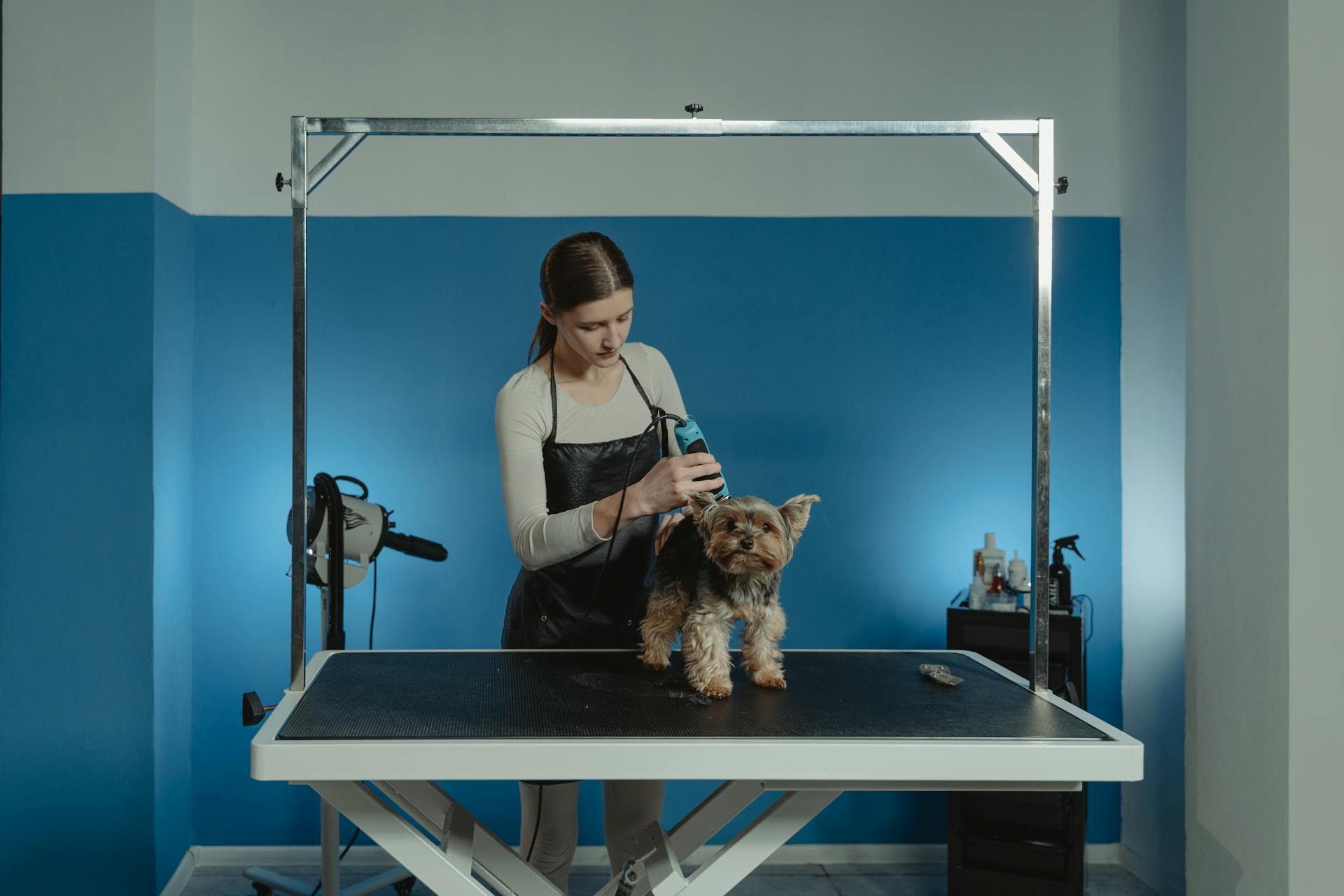
However, if left alone for too long with too little exercise, Border Terriers can become barkers and may even try to escape or dig in your yard.
To prevent this, it's essential to have a safe backyard and supervise your dog when they're outside.
Here are some breeds with similar maintenance needs to the Border Terrier:
- Canaan
- Manchester Terrier
- Basenji
- Australian Bulldog
- McNab
Frequently Asked Questions
How many Border Terriers are there in the UK?
As of 2022, the UK has approximately 4,494 registered Border Terriers. The breed's popularity peaked in 2011 with over 7,000 registered dogs.
What is the oldest Border Terrier in the UK?
The oldest Border Terrier in the UK is reportedly Alfie, a 17-year-old dog from Derbyshire. He holds the record as the oldest known Border Terrier in the UK, according to the Border Terrier Club.
Sources
- https://www.petplan.co.uk/pet-information/dog/breed/border-terrier/
- https://wagwalking.com/breed/border-terrier
- https://www.dogstrust.org.uk/dog-advice/getting-dog/breeds/border-terrier
- https://www.pdsa.org.uk/pet-help-and-advice/looking-after-your-pet/puppies-dogs/small-dogs/border-terrier
- https://www.thekennelclub.org.uk/search/breeds-a-to-z/breeds/terrier/border-terrier/
Featured Images: pexels.com

